

| ▲ CO2 laser cutter |
Housed in a very attractive enamelled steel case!
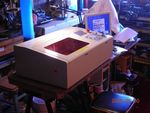 Overall view of machine |
40W sealed CO2 laser tube. Wavelength 10.6μm (far infrared).
Quoted lifetime is 800-1000 hours, but it isn't specified at what current this value was obtained. Presumably running the tube harder will reduce its lifetime.
The actual time spent cutting is probably small, given the time setting up the work, calculating settings etc.
Water cooling provided by a little aquarium pump.
 Laser tube |
Stepper motor driven axes with an on-board motion control card. It uses the usual 3-mirror flying optics arrangement to deliver the beam to the cutting head.
Each mirror is a gold-coated front-surface mirror, about 20mm diameter. The lens is zinc selenide, AR-coated with a focal length of around 50mm.
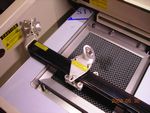 |
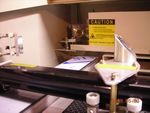 |
 |
The cutting bed can be lowered to accomodate articles up to 5cm in thickness. There is also a honeycomb cutting table. Second picture below shows adjustment knob for the table height.
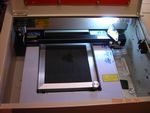 |
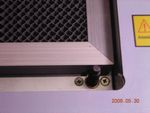 |
The optimum distance from the top of the lens support plate to the surface of the material being cut appears to be 57mm.
Front panel controls are keyswitch for main power, laser on switch, lighting on switch, laser test buttons, current adjust, and emergency stop.
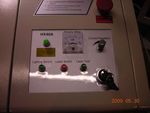 |
 |
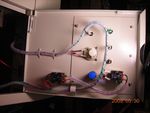 |
Important safety note: The laser power supply (the largest PCB in the enclosure) is a switchmode supply run from the mains. As a result, the current adjust potentiometer is floating at half mains potential (about 120V). I mention this in case you try to make some circuit to control the laser current automatically, e.g. from a computer!
The start/stop signal for the laser is OK, because it is optoisolated from the laser power supply.
I would also be a bit wary of whether the current control potentiometer can actually withstand that voltage to earth - note that the pot shaft is metal! When I make the attachment for a multiturn knob, I'll probably make it insulating, just in case.
Fan on the rear of the casing, pulling smoke away from the cutting area. Maybe not the most powerful, but it does work.
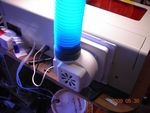 |
I later added an additional axial flow fan just under the roof where the vent exits - this roughly doubled the available airflow. It has the added benefit of acting as a general-purpose fume extractor when the laser cutter is switched off.
| ▲ CO2 laser cutter |